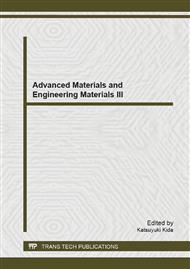[1]
R.N. Baxi, S.U. Pathak, D.R. Peshwe, Impact modification of a PET-PBT blend using different impact modifiers. Polym. J. 43 (2011) 801-808.
DOI: 10.1038/pj.2011.69
Google Scholar
[2]
S. Liu, S. Qin, Z. Luo, J. Yu, J. Guo, M. He, Reactive compatibilization of poly(butylene terephthalate)/acrylonitrile-styrene-acrylate blends by epoxy resin: morphology and mechanical properties. J. Macromol. Sci. B. Phys. 50 (2011) 1780-1790.
DOI: 10.1080/00222348.2010.549073
Google Scholar
[3]
S.L. Sun, X.Y. Xu, H.D. Yang, H.X. Zhang, Toughening of poly(butylene terephthalate) with epoxy-functionalized acrylonitrile-butadiene-styrene. Polymer 46 (2005) 7632-7643.
DOI: 10.1016/j.polymer.2005.06.011
Google Scholar
[4]
M. Xanthos, S.S. Dagli, Compatibilization of polymer blends by reactive processing. Polym. Eng. Sci. 31 (1992) 929-935.
DOI: 10.1002/pen.760311302
Google Scholar
[5]
H.T. Oyama, T. Kitagawa, T. Ougizaw, T. Inoue, M. Weber, Novel application of reactive blending: tailoring morphology of PBT/SAN blends. Polymer 45 (2004) 1033-1043.
DOI: 10.1016/j.polymer.2003.11.040
Google Scholar
[6]
W. Hale, H. Keskkula, D.R. Paul, Compatibilization of PBT/ABS blends by methyl methacrylate-glycidyl methacrylate-ethyl acrylate terpolymers. Polymer 40 (1999) 365-377.
DOI: 10.1016/s0032-3861(98)00189-x
Google Scholar
[7]
H. Wang, Q. Qian, X. Jiang, X. Liu, L. Xiao, B. Huang, Q. Chen, Melt rheological and compatibility properties of recycled poly(ethylene terephthalate)/ poly(acrylonitrile-butadiene-styrene) blends. J. Appl. Polym. Sci. 126 (2012) E266-E272.
DOI: 10.1002/app.36984
Google Scholar
[8]
H. Gramespacher, J. Meissner, Interfacial tension between polymer melts measured by shear oscillations of their blends. J. Rheol. 36 (1992) 1127-1141.
DOI: 10.1122/1.550304
Google Scholar
[9]
D. Chopra, M. Kontopoulou, D. Vlassopoulos, S.G. Hatzikiriakos, Effect of maleic anhydride content on the rheology and phase behavior of poly(styrene-co-maleic anhydride)/poly(methyl methacrylate) blends. Rheol. Acta. 41(2002) 10-24.
DOI: 10.1007/s003970200001
Google Scholar
[10]
R.G. Larson, The structure and rheology of complex fluids, Oxford University Press, (1999).
Google Scholar
[11]
H. Azizi, I. Ghasemi, M. Karrabi, Controlled-peroxide degradation of polypropylene: rheological properties and prediction of MWD from rheological data. Polym. Test. 27 (2008) 548-554.
DOI: 10.1016/j.polymertesting.2008.02.004
Google Scholar
[12]
A. Ajji, L.A. Utracki, Interphase and compatibilization of polymer blends. Polym. Eng. Sci. 36 (1996) 1574-1585.
DOI: 10.1002/pen.10554
Google Scholar
[13]
N.W. Tschoegle, The phenomenological theory of linear viscoelastic behavior: an introduction, Spinger-Verlag, Berlin, (1989).
Google Scholar
[14]
G. Guerrica-Echevarría, J.I. Eguiazábal, J. Nazábal, Interfacial tension as a rarameter to characterize the miscibility level of polymer blends. Polym. Test. 19 (2000) 849-854.
DOI: 10.1016/s0142-9418(99)00055-0
Google Scholar


